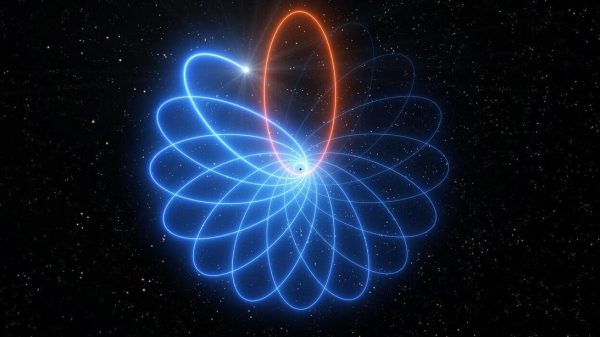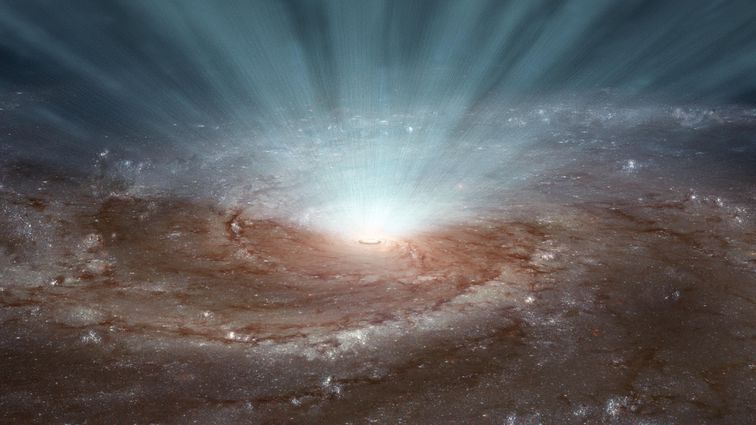Astronomers watch star dance with a black hole, proving Einstein right (again) – CNET

The Very Large Telescope watched a star for 27 years, measuring its movements around Sagittarius A* at the center of the Milky Way
ESO/L. Calçada
The mammoth black hole at the center of the Milky Way, Sagittarius A* (or, in short, Sgr A*), is orbited by a veritable buffet of stars which are beholden to its gargantuan gravitational effects. After three decades observing star S2, which orbits Sgr A*, an international collaboration of researchers at the European Southern Observatory (ESO) have come to a familiar conclusion: Einstein was right, again.
The study, published in the journal Astronomy & Astrophysics on Thursday, peered into the heart of our home galaxy and followed the movements of S2 over 27 years using the ESO’s Very Large Telescope, an all-seeing cosmic eye located in the Atacama Desert of Chile. S2’s orbit carries it close to the Milky Way’s supermassive black hole and this orbit provides a natural, experimental setting for astronomers to test out Einstein’s general theory of relativity.
That theory dictates how space, time and gravity interact and says huge, dense objects like black holes can warp space around them. When scientists went hunting for an image of a black hole in 2019, Einstein’s predictions about what they might see held true.
S2 swings around Sgr A* once every 16 years and gets quite cozy with the black hole (in astronomical terms), coming within about 12.5 billion miles (20 billion kilometers) — about four times as far as Pluto is from the sun. Even at those distances, the huge gravity of the supermassive black hole keeps S2 spinning back time and again — and for 27 years, ESO astronomers watched. In total, the research team nabbed 330 measurements of the star’s position and velocity.
“After following the star in its orbit for over two and a half decades, our exquisite measurements robustly detect S2’s Schwarzschild precession in its path around Sagittarius A*,” said Stefan Gillessen, an astronomer at the Max Planck Institute for Extraterrestrial Physics and a co-author on the paper, in a press release.
The work by the ESO team is is the first time this precession has been detected in a star orbiting the Milky Way’s black hole where precession is dominated by Einstein’s theory.
A Schwarzchild precession is an orbit predicted by Einstein’s theory. It sees one cosmic body drift around another in an orbit “shaped like a rosette” because of the extreme gravitational pull and bending of space-time.
Think of it like a clock face. At the center of the clock is a black hole and at the edge, right over the number 1, is a star like S2. As S2 swings into the center of the clock and passes around the black hole, extreme gravity and the curvature of space time rotates its orbit a little. It swings back out to the edge of the clock face, but finds itself positioned over the number “2” at the clock’s edge.
We can see precession in our own solar system — the way Mercury orbits the Sun demonstrates this, but the effects are largely driven by other planets tugging on Mercury. Every year, Mercury strays a little and its orbit rotates around our sun.
The research built on previous observations of S2 conducted by ESO showing how the light from the star shifted as it approached the black hole. This shift was also predicted by Einstein, who now seems impervious to taking an L when it comes to the very theory holding our universe together.
The Very Large Telescope will have some black hole-gazing competition in five years time when the Extremely Large Telescope is expected to be fired up. It’s hoped the team will be able to see stars which are even more faint and closer to the black hole, providing another chance to put Einstein’s theory to the test.
“If we are lucky, we might capture stars close enough that they actually feel the rotation, the spin, of the black hole,” said Andreas Eckart, an astrophysicist at Cologne University and co-author on the paper. “That would be again a completely different level of testing relativity.”
My money’s on Einstein chalking up another win.

16 Photos
Originally published 12 a.m. PT





